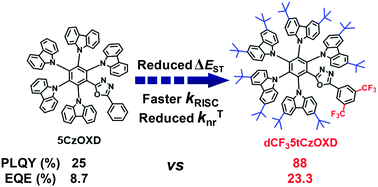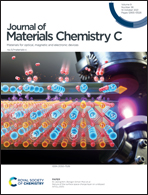Manipulating peripheral non-conjugated substituents in carbazole/oxadiazole hybrid TADF emitters towards high-efficiency OLEDs†
Abstract
The chemical modification of existing thermally activated delayed fluorescence (TADF) materials is a simple strategy to increase the luminescence efficiency and is also favorable for a deeper understanding of the structure–property relationship. In this work, based on a previous multi-functional carbazole/oxadiazole hybrid light-blue TADF emitter 2-(2,3,4,5,6-penta(9H-carbazol-9-yl)phenyl)-5-phenyl-1,3,4-oxadiazole (5CzOXD), a series of 5CzOXD derivatives have been designed by rationally introducing non-conjugated electron-donating tert-butyl (t-Bu) units at the 3- and 6-positions of carbazole and/or electron-withdrawing trifluoromethyl (CF3) units at the para- or meta-positions of the terminal phenyl ring in the diphenyl-1,3,4-oxadiazole group. The TADF emission colors were slightly affected by non-conjugated peripheral substituents, while a singlet–triplet band gap (ΔEST) value could be easily tuned from 0.24 to ∼0 eV. It is interesting that through step-by-step chemical modification, progressively increased photoluminescence (22–88%) and electroluminescence (2.3–13.7%) quantum efficiencies could be achieved for the TADF emitters in doped films of the o-CzOXD host matrix. Similar trends were also obtained for 26DCzPPy-hosted TADF OLEDs. For example, bare 5CzOXD showed a maximum external quantum efficiency (EQE) of 8.7%, the value of t-Bu-modified 5tCzOXD was increased to 14.2%, and even higher EQE values in the range of 20–22% were obtained for t-Bu and single CF3-substituted mCF35tCzOXD and pCF35tCzOXD. The best EQE value of 23.3% was achieved for dCF35tCzOXD by synergistical t-Bu and double CF3-substitution due to its ∼0 eV of ΔEST for a significantly increased reverse intersystem crossing rate and a decreased triplet non-radiative decay rate. This work provides an effective strategy for achieving high-efficiency TADF OLEDs through the modification of currently less efficient TADF emitters.



 Please wait while we load your content...
Please wait while we load your content...